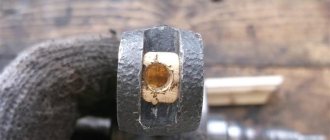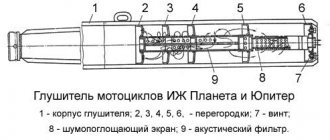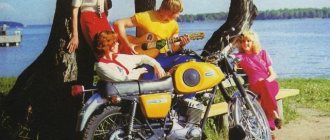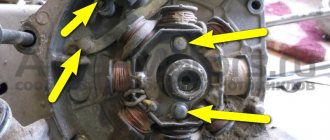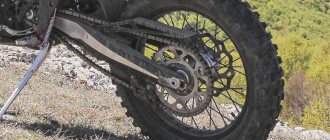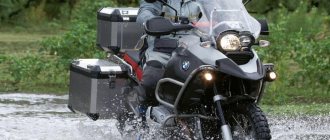Why is it worth ordering spare parts from us?
If you have already selected a suitable option, simply fill out the online form on the website, and if you can’t make a choice, call our consultants. Depending on the nature of the breakdown, we will help you decide on the purchase of rare spare parts for the Izh, Jupiter and Planet motorcycles. All specified components come with a quality guarantee. You will return your vehicle to working order with minimal investment of time and money.
The advantages of working with us are the extensive experience of our specialists in selecting components for Soviet motorcycles, the availability of even rare samples and the supply of only original and high-quality spare parts from reliable manufacturers.
Izha fork: design and disassembly
Vehicles of five models and modifications roll off the IZHMASH production line: IZH 7.107 (Planet-5), IZH 7.108 (Planet-5K), IZH 6.113-01 (Jupiter-5-01), IZH 6.114-01 (“Jupiter 5-01K”) and IZH 7.107-015 (“Planet-5-015”).
the motorcycle in the so-called “fifteenth configuration” is equipped with a new front fork, cast wheels and a hydraulically driven front wheel disc brake: three units manufactured under license from Japan. This, in fact, is the difference between the IZH 7.107-015 motorcycle and the regular IZH 7.107.
In this article we will consider only one component - the front suspension. Deputy Chief Designer V. RUDENKO talks about it.
Rice. 1. Installation of the front fork: 1,2 - casing; 3 - bolt; 4 - nut; 5 — washer; 6 — steering column lock washer; 7 — nut M26 X 1.5; 8 — upper bridge; 9 — cap; 10 — protective washer; 11 — ball bearing; 12 — head part of the frame; 13 — special ring; 14 - gasket; 15 — lower bridge; 16 — steering column axis; 17, 18 — shock absorber strut.
The front fork, as usual, consists of guide devices. elastic elements and vibration dampers. The guide devices ensure the specified movement of the wheels relative to the frame and transmit movement resistance forces and braking forces to it. Elastic elements perceive and soften impacts transmitted through the wheels to the sprung parts. Damping devices reduce the time of forced oscillations and turn these oscillations into damped ones.
Motorcycle front suspensions are usually made in the form of telescopic and lever forks. Telescopic forks are the most widespread - they are found on all IZh models. The licensed fork we are considering also belongs to this type.
It is based on two struts 17 (left) and 18 (right) of shock absorbers (Fig. 1), fixedly fixed in the upper 8 and lower 15 bridges, which, using the steering column axis 16 and two ball bearings 11, are pivotally connected to the head part of the frame 12 This device allows you to rotate the fork (and with it the front wheel) relative to the frame, changing the direction of movement. Shock absorber struts are stationary elements of guide devices. Each rack is secured in the upper and lower bridges with bolts 3 and nuts 4. In the areas between the bridges, the racks are covered with casings 1 and 2. The headlight is fixed to the brackets of the casings.
The working part of a fixed pipe is called a cylinder. The outer, movable part of the fork leg slides along it, having a reservoir 22, a piston 21 with a ring 18 and a rebound spring 19. Inside the fixed pipe there are a large 8 and a small 12 spring. The tightness of the connection between the movable and stationary parts of the feather is ensured by a sealing unit, which consists of two cuffs 15, a retaining ring 17 and a protective cover 13, secured to the movable pipe with a clamp 14 and on the non-moving pipe with a clamp 10.
The role of the elastic element in each rack is performed by the already mentioned large and small springs, which have different stiffnesses; this provides the necessary nonlinearity of the suspension characteristics.
In addition, compressed air is used as an elastic element in the suspension under consideration: it is pumped into each airfoil through spools 2. This is the first time this solution has been used on our motorcycles - and therefore we pay special attention to this!
In order for the feathers to work equally, you need to strive to ensure that the pressure in the left and right feathers is as equal as possible. At least the difference should not exceed 0.1 kg/cm2.
If the motorcycle is used by only one driver and his build is not very different from the average, the pressure in the seats should be maintained at approximately 0.2 kg/cm3; if he travels with a passenger - 0.4 kgcm3; and when driving with a stroller - 0.6 kg/cm3. These are, of course, only approximate values. Each driver will very soon set the optimal ones for himself, based on specific conditions. The new struts are much stiffer than the old ones, since the outer diameter of the 20 cylinders has been increased to 38 mm. In addition, the suspension has an unprecedentedly long travel - up to 200 mm. And all this together allows us to say that the new front fork has significantly increased the comfort and safety of riding a motorcycle.
A few words about the vibration damper.
Extinguishing occurs due to the resistance forces that arise when the oil is throttled through a special valve device rolled in the lower part of the working cylinder 20, and also due to the slow flow of the same liquid through the annular gaps between the piston 21 and the inner walls of the cylinder 20 and through the holes in the piston .
Rice. 2. Shock absorber strut: 1 — cap; 2 - spool; 3 - cover; 4 - nut; 5 — small o-ring; 6 — large sealing ring; 7 — upper cup; 8 — large front suspension spring; 9 — valve nut; 10, 14 — clamp; 11, 16 — bushing; 12 — front suspension spring small; 13 — cover; 15 - cuff; 17 — retaining ring; 18 — piston ring; 19 — rebound spring; 20 — working cylinder with valve; 21 - piston; 22 — tank cylinder; 23 - tip; 24 — sealing washer; 25 — screw M10x1.25; 26 — axle holder; 27 — washer; 28 — M6 nut; 29 — M6 pin.
In conclusion, I would like to give some tips regarding the operation and repair of a new fork.
Practice has shown that the fork works quite stably, there are no major complaints about it. However, you need to ensure that the threaded connections are securely tightened, prevent fluid leakage, and systematically check the pressure in the pneumatic pumping system. Pay attention to the safety of protective covers. If you discover any malfunction, try to fix it as soon as possible, without delaying it until later: otherwise, a minor malfunction will certainly turn into a major one.
Since motorcyclists do not have to rely on service, here are some tips for servicing a new suspension.
I recommend replacing the hydraulic fluid for the first time after 2500 km - that is, immediately after the end of the break-in. This should not be neglected, since oil is not just a working fluid, but also a lubricant for the pen parts. If it is contaminated - and during the break-in period this process is especially active - the oil will contribute to increased wear of rubbing parts.
The next oil change should be made after 6-7 thousand kilometers, using 300 cm of MGP-10 fluid (OST 38.1.54-74) for each feather. Unfortunately, replacement can only be done when the stand is removed - this is not entirely convenient for the consumer. However, if you consider that the annual mileage of a motorcycle rarely exceeds 10 thousand km, then this operation, performed at the beginning and end of the season, will not seem so burdensome.
To remove and disassemble the rack, the following sequence of actions is recommended.
Place the motorcycle on a stand and remove the front wheel. Disconnect the front disc brake caliper from the movable pipe. Remove the front fender together with the stamped bridge by unscrewing the bolts securing it to the bosses of the left and right movable pipes.
Remove the caps 3 from each stand (Fig. 2). By pressing spool valves 2, remove air from the upper cavity of the shock absorbers. Unscrew the nuts of the 4 working cylinders halfway. Loosen the coupling bolts in the lower and upper bridges, then knock the struts out of the bridges using a wooden spacer with light hammer blows on nuts 4 and remove them from the motorcycle.
To change the oil, all you have to do is unscrew nut 4 completely, remove large spring 8, bushing 11 and small spring 12 from the pipe. Be careful when you finally unscrew nut 4: springs press on it from below and it can “shoot”. Turn the rack over and drain the oil. Rinse the cylinder with clean unleaded gasoline and blow dry with compressed air.
Assemble the racks and install them on the motorcycle in the reverse order.
If it becomes necessary to replace seal 15, the rack should be completely disassembled. After draining the oil, remove the protective cover 13, unscrew the screw 25 and remove the cylinder 20 along with the piston 21 from the reservoir 22. By removing the retaining ring 17, you will be able to remove the cuffs 15 and replace them with new ones. To prevent oil leakage in the lower part of the rack before tightening screw 25, it is recommended to lubricate its threads with a thin layer of UNIGERM-6 sealant.
Deputy Chief Designer V. RUDENKO
Motorcycles Ural and Dnepr
Wylde
Some of the owners of the opposition ones tried to install a similar device on their motz instead of the original plug or some other thread.
The outer diameter of the PS fork is 35, the inner diameter is 29, the length from the wheel axis to the top of the stays is 85... I heard that it is unsafe to install such a miracle - it may simply not stand. In comparison with the fork from ChZ (there are diameters 36 and 30), it turns out to be 1 mm thicker than the PS'ovskaya... So it’s worth it or not... I think it’s easier and safer to lengthen the original Dnieper seatstays Havoc
I did, and now it’s the one that’s worth it. The rigidity of the PSa fork in terms of torsion and bending is significantly better than the original Ural-Dneprov ones. And the brakes will be richer. But all this is subject to native traverses. But with spare parts GEMOR. Even in Moscow, GEMORRROOOOOYYYY. . So I'm changing it myself. season on Orionovskaya. So think for yourself. But the quality and characteristics of the hydraulics are better than all domestic hydraulics, not even by a head, but by an order of magnitude. Ten times! If you have questions, ask, OK?
Good luck .
Havoc
And lengthening the feathers, especially with extensions on top, is really very unsafe.
It's a kind of lottery, but just remember. Yes, and support the same thing. Wylde
2 Havoc Listen, what if you lengthen the PS???
That’s exactly what I wanted to do, and then I thought... no, it’s better to use the Dnieper one - it’s thicker in diameter and on the walls. By the way, about the details... what exactly are the hemorrhoids among them (seals or something) because if you lengthen it, you will have to tinker with the insides Wylde
A!
And one more thing... The travers will be machined accordingly... Maybe the Dnieper one after all... Padre
I made a hybrid of the Ural and PS forks, but I ran into a problem with the axle... the non-Ural non-PS axle now does not fit... what to do???????
Messer
How much longer is the Orion Fork longer than the Dnieper Fork?
I don't want to increase the fork angle for the sake of authenticity of the bike's silhouette - and I really don't want to ride with the nose of the bike up. Maybe it can be shortened somehow? Or as an option: no one has tried to soften the Dnieper fork - maybe some Izhevsk springs will do? gad
This is what I’m thinking - install Dog feathers and a wheel, and homemade traverses.
So the question is - will this be good and what material is better for the traverses - I can’t find 45 steel, they offer 30 hgsa. How can such a piece of hardware make a decent device? Wylde
quote: I did it, and now it’s the one that stands. The rigidity of the PSa fork in terms of torsion and bending is significantly better than the original Ural-Dneprov ones. And the brakes will be richer. But all this is subject to native traverses
This happens... I would never believe that the PS fork is stronger, in terms of bending and torsion, than the Dnieper fork.
Dneprovskaya will be thicker... What's the point here? And another question - all these holy PS are only with native traverses??? What if I want to lengthen it and grind new traverses? skyfox2002
wylde/ the fact is that the PS fork is designed for high force impacts at different angles, the Dnieper fork is a different situation, it is powerful in appearance and in its class it is good, but again everything is relative, if you use the PS, then absolutely nothing bad will happen, and even vice versa.
but nothing lasts forever and nothing can be done about it, the main thing here is to figure out what goals you are pursuing Wylde
2skyfox2002
So that’s what I’m saying... I’m going to lengthen it.
About 15 cm... Well, there is an alternative to lengthen the Dnieper, but according to the information that was above, I am now leaning more towards the PS. So is it worth doing this? skyfox2002
wylde/it's worth doing, but there is a small ,, but ,, , do you want to lengthen the fork itself or make a stem by digesting the front part of the frame?
In general, you need to lengthen the fork within reasonable limits, otherwise controllability/maneuvers during turns will suffer, the pits are small, and a large lever upon impact will violate the geometry of the frame. put it as it is. Wylde
quote:
do you want to lengthen the fork itself or make a stem by digesting the front part of the frame
I don’t understand... So, lengthening the fork usually means overcooking the front part of the frame.
What could we do without it? Driving with your nose in the air? And they lengthen it and digest it in order to increase the take-out later... In general, we are talking about something else. Will a dog fork (extended by about 15 cm) withstand a lightweight boxer fork? And further! I heard a trick the other day that a type of dog fork can easily be converted from hydraulic to pneumatic by replacing the seals with new ones and installing nipples in the plugs for the feathers. Maybe? skyfox2002
wylde/ buddy, I don’t know how you’re going to install it.
suddenly you turn it on without digesting the frame and proudly like a wonderful bird you will fly on your mozil. In general, the bicycle was invented a long time ago. put it as it is /constructively/. boxer
quote:
This is what I’m thinking - install Dog feathers and a wheel, and make homemade traverses. So the question is - will this be good and what material is better for the traverses - I can’t find 45 steel, they offer 30 hgsa. How can such a piece of hardware make a decent device?
35xgsa is twice as strong as plain 45 steel.
35xgs is used to make an axle that serves the motorcycle posthumously. and if you make it out of 45, it will last 2-4 seasons. Wylde
2Boxer Whoa!
Drop dead!!! Can you tell me a little more about 35xgsa? I was very interested. And what can such a fork do on a Lightweight Izh??? What for do you mean it is needed there with such parameters? Havoc
Fork on PS from the coolest Yamaha, licensed.
And if possible, find and install PS traverses, the top one is aluminum. The quality and appearance are superb. And 30KhGSA steel is really very good, it can’t be compared with St45. NO WAY!!! And if you make traverses, then not st45, st3, because steel 45 likes to crack when heated and welded. It is only good for axles and bolts, and even then they are not very important. Desert_Eagle
Don't worry, install a better Orion one with a disc brake
Wylde
2Desert_Eagle Fuck you
